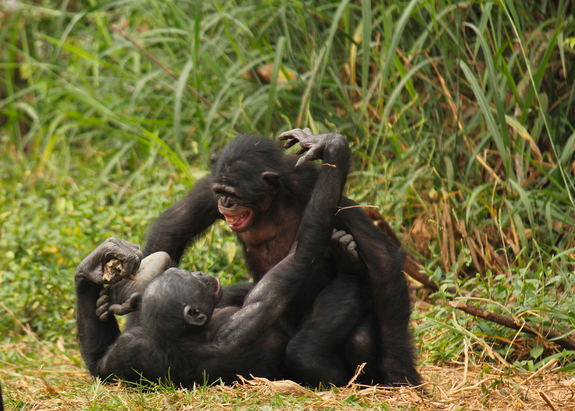Love & Lust: 7 Lessons from the Animal Kingdom
NEW YORK — Sex. Many (but not all) animals do it. Partners come together to combine their genetic material in hopes of creating a healthy next generation for passing down their genes.
For humans, romance, love and sometimes Valentine's Day can be involved, although the formula varies greatly depending on culture. Meanwhile, other animals go about it in a dizzying variety of ways. Creatures may form pair bonds or mate promiscuously, like bonobos. Corals and fish spew their eggs and sperm out into the environment to unite there.
A panel discussion at the New York Academy of Sciences on Tuesday (Feb. 12) explored how lust, and sometimes love, are manifested throughout the animal kingdom, past and present. Here are some of the top lessons science has taught about love and lust:
First, figure out who's who. "Sexing," the scientific term for figuring out whether an individual is male or female, has been a challenge for paleontologists studying dinosaurs. Looking for skeletal differences just didn't work, said panelist Brian Switek, who writes about dinosaurs and is the author of a forthcoming book, "My Beloved Brontosaurus: On the Road with Old Bones, New Science, and Our Favorite Dinosaurs" (Scientific American/FSG). In recent years, however, the task has become more feasible. For instance, paleontologists have begun looking in fossils for what is called medullary bones. Among birds, which experts consider to be living dinosaurs, females store calcium for egg-laying in this temporary bone tissue. [Top 10 Swingers of the Animal Kingdom]
Fatherhood can be complicated. "Thanks to molecular testing, we can now genetically trace, like Maury Povich, who's the daddy," said Danielle Lee, who studies animal behavior and behavioral ecology at Oklahoma State University. The results of testing: The female's social partner may not be the father of any of her young. Moderator Joshua Ginsberg of the Wildlife Conservation Society pointed out that the same phenomenon applies to humans. The man on the birth certificate is not always the biological father, although the rates at which this happens vary widely depending on the population. Marina Cords, a professor at Columbia University who has studied blue monkeys for 30 years, said that the female monkeys who live in harems "seem to get pretty tired of the one guy." She added, "They sneak around, too."
There's more than one way to get the girl. Not all males within a species are created equal. Among some animals, such as salmon and squid, some males invest more energy in acquiring the traits attractive to females. "Others are smaller: the wimpies, if you will," Lee said. These are the "sneaker males," which use their innocuous presence to their advantage to mate furtively with the females.
Don't believe in animal love at first sight. For humans, it's easy to interpret animal interactions as evidence of love. Cords, who studies monkeys, noted that she attempts not to attribute human characteristics to her study subjects, but "the question is, how do you know?"
Work in psychology that looks at the behavior of mothers and babies to assess their attachments has some applicability to nonhuman primates, she said. "I think that is a way of measuring what I would perhaps call akin to human love," Cords said. "I think it has to do with attachment and a certain feeling you have when you are with someone and you miss someone when you are not with them." In addition to behavior, primatologists can look at hormone levels, she said.
Simulated sex can't trump a good specimen. Work with paleontologist Heinrich Mallison's digital model of Kentrosaurus, which resembled Stegosaurus with more spikes, has shown that the male dinosaur could not have been realistically expected to mount the female from behind, "doggy-style." Instead, the results suggest the female lay on her side, Switek said. He and Mallison are now working on a related paper. The science of dinosaur sex needs good fossil specimens, he said, citing the discovery of 50-million-year-old turtles preserved while mating. "It would be fantastic if someone found this in dinosaurs," he said.
Scientists' experiences and biases shape their questions. Lee, who works with rodents, has begun conducting experiments on the degree to which pairing a female with a male she prefers affects her success having offspring. This is the sort of question that would occur to a female ecologist like herself, but not necessarily to a man. Responding to a question about homosexuality in animals, she said it had not occurred to her to investigate whether adult females nesting together constituted any homosexual behavior. “That is why we need more diverse scholars within those fields to ask those questions,” she said. [The Animal Sex Quiz]
Love is a turn-on for the human brain. When Stephanie Cacioppo, a neuroscientist at the University of Chicago, and colleagues showed people pictures of their beloved partners and recorded their brain activity, they saw increases in the release of dopamine, a chemical signal associated with rewarding experiences, and the release of oxytocin, a signal that is associated with pair bonding and empathy. For people who reported feeling madly in love, a part of the brain known as the angular gyrus became activated. This region is also associated with self-representation and language, she said.
Follow LiveScience on Twitter @livescience. We're also on Facebook & Google+.
Copyright 2013 LiveScience, a TechMediaNetwork company. All rights reserved. This material may not be published, broadcast, rewritten or redistributed.



